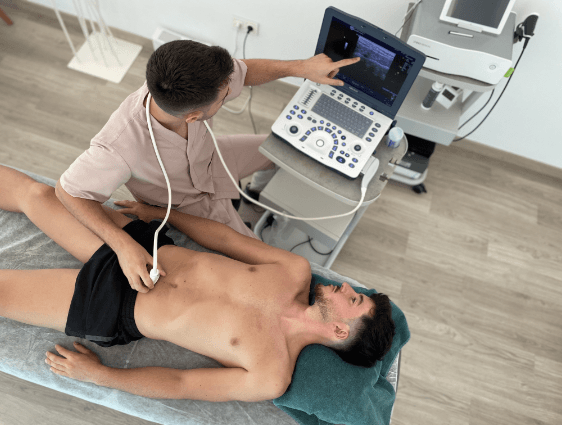
An increasingly important technique within the clinical practice of the physiotherapist.
Musculoskeletal ultrasound is an important tool we use to prepare an objective clinical diagnosis for the patient. Furthermore, musculoskeletal ultrasound allows us to safely and accurately perform various invasive techniques, such as: dry needling, which involves complex muscle approaches in the vicinity of delicate neighboring structures such as neurovascular bundles, ganglia or an organ; percutaneous neuromodulation, where it is used to locate the peripheral nerve that we want to treat, and; EPTE, where it provides greater efficacy by allowing for precision entry of the needle in the area in which the tendon injury is located.
This technique is becoming increasingly valuable within the clinical practice of the physiotherapist, for physiotherapeutic diagnosis as well as for the subsequent treatment.. There is significant, reliable scientific evidence that supports the use of ultrasound in the clinical reasoning process. It allows the physiotherapist to understand and interpret the deficiencies presented by the patient in the best possible way.
Así funciona la ecografía musculoesquelética
Usaremos ondas de sonido de alta frecuencia; para ello, nos apoyaremos en sistemas de ultrasonido que se componen por una pequeña sonda conectada a un dispositivo con una pantalla de visualización. De esta forma, la sonda explora el área de nuestro cuerpo expulsando ondas de alta frecuencia; las ondas de sonido se transmiten al sistema de ultrasonido para ser convertidas en imagen.

Ultrasound only allows us to see soft tissue, that is, periarticular cartilage, ligaments, nerves, muscles, and tendons. As for bones, we can only visualize the cortical bone since, due to its high density, ultrasound cannot penetrate it. This allows us to identify certain traumatic or stress fractures and fissures, although in these cases the most accurate diagnostic test would be radiography (X-ray).
Tell us about your particular case. We can explain whether musculoskeletal ultrasound is right for you. Furthermore, at the LH Physiotherapy Clinic, we will conduct a preliminary study that details the steps to follow.


